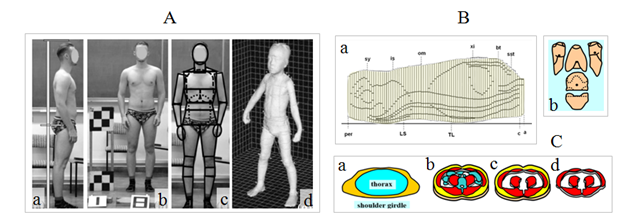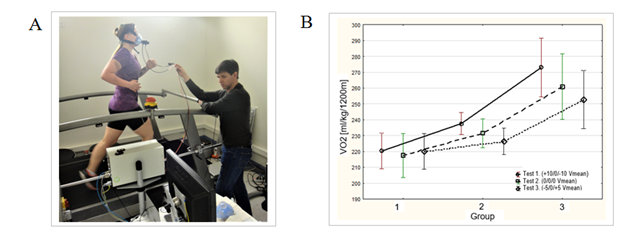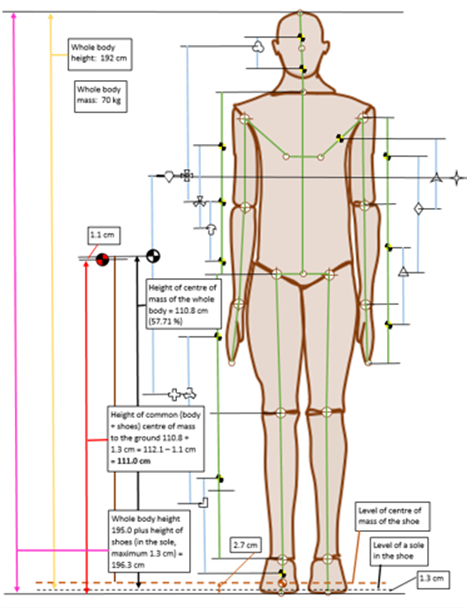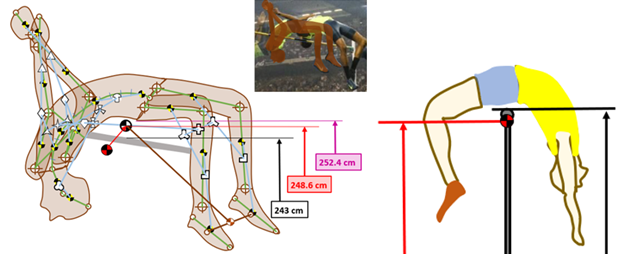MOJ
eISSN: 2576-4519


Review Article Volume 4 Issue 1
Gdansk University of Physical Education and Sport Gdansk, Poland
Correspondence: Erdmann WS, Laboratory of Biomechanics and Sport Analytics and Engineering, Gdansk University of Physical Education and Sport Gdansk, Poland
Received: December 22, 2019 | Published: January 9, 2020
Citation: Erdmann WS, Aschenbrenner P, Dancewicz-Nosko D, et al. University laboratory of biomechanics and sport analytics and engineering in Gdansk as an important science institution. MOJ App Bio Biomech. 2020;4(1):1?6. DOI: 10.15406/mojabb.2020.04.00124
Polish scientific biomechanics started in 1920s. This was applied at first to the biomechanics of physical education and sport. Institutional biomechanics in Gdansk started in 1971. Main areas of research of Gdansk center were: 1) human morphology, 2) human kinesiology, 3) muscle mechanics, 4) biomechanics of sport – general approach and many applications to sport disciplines, 5) image methods used for research of movement, 6) sport engineering, 7) biomedical engineering, 8) forensic biomechanics. In 2019 scientists of the Laboratory of Biomechanics and Sport Analytics and Engineering were engaged in the following areas of interest: 1) geometry and inertia of athletes, 2) distribution of velocity along the running track, 3) biomechanics of speed skating, 4) high jumping in athletics, 5) forensic biomechanics. There are altogether about 30 scientific areas developing by the Gdansk sport scientists specializing in biomechanics, analytics, engineering, many of them on the world level including at the best world level.
Keywords: body morphology, velocity distribution, speed skating, high jumping, forensic opinions
Biomechanics as a science appeared in Greek Ancient times (Aristotle).1 Modern approaches started with the work of Borelli in Italy in the 17th century.2 Biomechanics of sport started at the end of the 19th century when Muybridge in the United States and Marey in France presented photographic multiple images of athletes during their movements.3,4 In Poland biomechanics started at the first half of the 20th century. This was applied at first to the biomechanics of physical education and sport. In 1921 Piasecki in Poznan wrote on the necessity of analysis of mechanics of movement for physical education major students. His idea was introduced to the curriculum by Kaminski in 1928.5 In Warsaw Poplewski (since the half of 1920s) lectured biomechanics for physical education major at the university level.6 During the second half of the 20th century especially the following researchers developed biomechanics of sport in Poland (chronologically): Kabsch,7 Fidelus,8 Bober,9 Wit,10 Dworak.11 In 1971 Erdmann (who studied physical education major and then as supported studies machine building major) established the first Biomechanics Laboratory at the College of Physical Education (today: Gdansk University of Physical Education and Sport) in Gdansk. The main areas of research of the Laboratory of Biomechanics, then Department of Biomechanics, Department of Biomechanics and Sport Engineering, and now again Laboratory of Biomechanics and Sport Analytics and Engineering, were: 1) human morphology, especially geometry and inertia, 2) human locomotion, especially technics and tactics of athletes (in athletics, alpine and cross-country skiing, swimming, rowing, handball, football/soccer), 3) kinesiology, 4) muscle mechanics, especially investigations of strength of muscle groups based on measurement of force of dynamometer resistance and its force arm and calculation of muscle group force arm from the length of the body part at which the muscle group acts, 5) biomechanics of sport in general and in many applications to several sport disciplines, 6) image methods used for research of movement from ancient times up to the 21st century, 7) sport engineering, 8) biomedical engineering, 9) forensic biomechanics.
The main publications of the Gdansk center in the forms of monographs, articles, conference presentations, dissertation theses, were: on general biomechanics,12 biomechanics of judo,13 image methods in sports,14 engineering of movement rehabilitation,15 geometry and inertia of the human trunk divided onto five parts16-18, biomechanics of tactics of alpine skiing,19 biomechanics of soccer,20,21, biomechanics of high jumping,22 biomechanics of tactics of rowing.23 In 2019 scientists of the Laboratory of Biomechanics and Sport Analytics and Engineering were engaged in the following areas of interest: 1) geometry and inertia of athletes, 2) distribution of velocity along the running track, 3) biomechanics of speed skating, 4) high jumping in athletics, 5) forensic biomechanics.
Geometry and inertia of the human body
Research activities of geometry and inertia of the human body, especially of athletes, is important scientific problem in the area of anthropology and biomechanics. Body build influences mechanical characteristics of movement since the body creates some resistance overcome by muscle or external forces. For example, length of lower extremities influences stride length, area of body surface perpendicular to the direction of movement acts on air or water resistance, volume of the body is important in buoyancy (Figure 1). Detailed measuring of the body is also necessary for the purpose of orthopedic surgery. Mass of the body is a measure of inertia (resistance) in transversal movement, while moment of inertia (mass and its distance from the axis of rotation) is a measure in rotational movement. These problems were described in a publication in scientific journal24 and also as a chapter in monograph published in USA (Figure 2).25

Figure 1 Examples of illustrations from the article in Acta Physica PolonicaA [24]: A – different techniques of obtaining external geometrical dimensions of the body (a – anthropometer, b – photogrammetry, c – modeling, d – laser use, courtesy of Hamamatsu ); application of computerized tomography (B) for obtaining internal images of layers of the body (a) for trunk parts (b); and their tissues (C) (a – division of a layer onto trunk parts, b – whole layer including bone and digestion tissues, c – muscle and adipose tissues, d – muscle tissue).

Figure 2 Examples of illustrations from the chapter of the monograph A Closer Look at Biomechanics [25]: A – adaptation of devices of sport engineering for dimensions of the athlete’s body: a – volleyball, b – gymnastics, c – rowing; B – devices of orthopaedic engineering which need to be adjusted to the dimensions of patient’s body: a – lower leg prosthesis, b – flex-foot, c – exoskeleton.
Distribution of velocity along the running track
Through the last a dozen or so years Erdmann and his collaborators from Gdansk biomechanics performed investigations on movement (distribution of velocity along the distance) in many sport disciplines. It was revealed that during prolonged effort (running, swimming, speed skating, skiing, bicycling) when a world record was obtained or athletes won in prestigious competitions they have specific distribution of velocity. Based on these investigations Erdmann26 introduced a biological law which says: in order to win in prolonged effort it is the best to begin very well but to end even better with minimalization of deviations from the velocity trend. Above investigations were aimed at professional athletes. The aim of the next investigations realized since few years, including 2019, by Erdmann, Urbanski and Aschenbrenner, and Dancewicz-Nosko27 were investigations of distribution of velocity of fit persons but not engaged in professional sport (students of physical education major). The subjects performed running at the distance of 1200 m on stadium track with the best time. The most often profile of the velocity had a saddle like shape. Students began faster, then slowed down and before the finish they ran again faster. Next, subjects performed a run on a treadmill with the same average velocity (though diminished according to the stadium velocity at 5 and 10 %): a) with lowering velocity, b) with steady velocity, c) with rising velocity. All above runs were performed in different days. During the run oxygen consumption by the subjects’ organism was measured. It was found the highest volume of oxygen was used during the run with lowering velocity and the lowest volume during rising velocity (with the same average velocity). These findings were especially seen in poorest runners and weak in the best runners. The conclusion was acquired, it is not good idea to begin the run too fast. It is better to begin the run moderate and then to rise velocity with the approaching the finish line (Figures 3&4).28

Figure 3 Research activities at the stadium of distribution of velocity at a distance of 1200 m: A – students waiting for the start command at every 20 s; B – a diagram with gathering time at every 200 m (times were obtained with the video camera). Students had heart beat sensor in order to check their involvment into the run. It was found the involvment was high.27

Figure 4 Laboratory investigations of distribution of velocity at a distance of 1200 m: A – a subject runs on a treadmill; B – diagram of oxygen consumption by three groups; better at left), medium, worse (at right) when they ran with different distribution of velocity with the same average value of velocity.28
Biomechanics of speed skating (long track)
Since many years Gdansk biomechanists are engaged in research of winter sports: alpine and cross-country skiing and lately in speed skating at the long track. At the end of 2018 we participated in research work during World Cup which took place in Ice Arena in Tomaszow Mazowiecki. In 2019 the first elaborations were presented during the scientific meeting (Figures 5&6).29,30

Figure 5 Biomechanical research of speed skating: A – slim body of a competitor, B and C – leaned body gives smaller frontal area, D – enormously enlarged quadriceps femoris muscle (athlete after the run).29

Figure 6 Investigations of distribution of velocity in speed skating: A – after the first 100 m it is hard to say who will be the winner in 500 m distance; B – further fragment shows strong correlation of time with the end time; C – the male winner at 10 km had rising velocity profile along the distance (this is in accordance with the Erdmann’s law on distribution of load); quasi-full = without the first 400 m.30
Athletics’ high jumping
In 2019 an article was prepared for Journal of Biomechanics on inertial quantities – mass, location of centers of mass, especially five parts of the trunk, obtained based on individual anthropological–biomechanical measurements of fit, young subjects. They were control group to high jumpers.31 Beyond this Erdmann prepared Report on high jumping in which he included several research activities of this athletics discipline, and also analyses of jumps of the competitors: a) Richard D. Fosbury from USA (innovator of flop technique), b) Javier Sotomayor from Cuba (world record holder, 245 cm), c) Stefan Holm from Sweden (being 180 cm tall he cleared the bar at the height of 240 cm), d) Mutaz E. Barshim from Qatar (actually the best world high jumper, his personal best is 243 cm). Barshim has a Polish coach, namely Stanisław (Stanley) Szczyrba. Erdmann met him at the IAAF World Championships in October 2019 in Doha (Qatar). After returning home Erdmann has sent to him and to Qatar Athletics Federation a Report on high jumping. The Report has been also sent to the Polish Athletics Union (Figure 7).32 Within some world elaborations location of center of mass when an athlete is over the bar, is presented substantially (up to about 25 cm) below the bar, which is wrong.
Forensic biomechanics
Since 1994 Erdmann elaborated more than ten expert opinions for the needs of justice institutions (courts, prosecutors, military police). Such opinions with taking into account hitherto existing legal proceedings (selected problems having connections with the opinion), visit to the scene of the incident, often with the conducting of procedural experiment, are written on tens of pages. In 2019 the following opinions were commissioned to Erdmann: a) for the need of Regional Prosecutor in Legnica (the case was about deadly accident of the pupil during cross country lesson; pupil was guilty of the wrong doing);33 b) for the need of Regional Court in Ilawa (the case was on payment of Guarantee Insurance Fund for the victim of the car accident; it was said that healthy person is a fit person and the victim of an accident should be paid large amount of compensation because she will never be fit).34 At the end of 2019 Erdmann gathered few opinions from the area of physical culture and presented them together during scientific meeting.35
Altogether research activities of the Laboratory of Biomechanics and Sport Analytics and Engineering of the Gdansk University of Physical Education and Sport encompass almost 30 scientific areas:36


Figure 7 Research on high jumping – location of center of mass during upright standing (A) and during clearing the bar (B) by Mutaz E. Barshim. While the sport world record holder is Javier Sotomayor (245 cm, he bent a bar a little bit), so biomechanical world record holder is Mutaz E. Barshim (252 cm). Center of mass (red line) was located together with his shoes. C – proposition of Erdmann’s technique of high jumping with upper extremities below the head (black color – position of the bar, red – position of center of mass).32
Above mentioned areas of scientific interests are mostly on the world level and many of them are developed on the best world level. Professor Julian Hong, president of the International Society of Biomechanics in Sports, considered Erdmann as one of the leading biomechanists in the world.37
In conclusion it can be said this article plays a role as information on what was done in the example of Central Europe laboratory devoted to biomechanics, sport, engineering. It is a forum of exchanging information with other scientific circles all over the world. It is also an invitation to possible cooperation between scientists from different parts of the world.
None.
The authors declare, that there is no conflict of interest.
None.

©2020 Erdmann, et al. This is an open access article distributed under the terms of the, which permits unrestricted use, distribution, and build upon your work non-commercially.